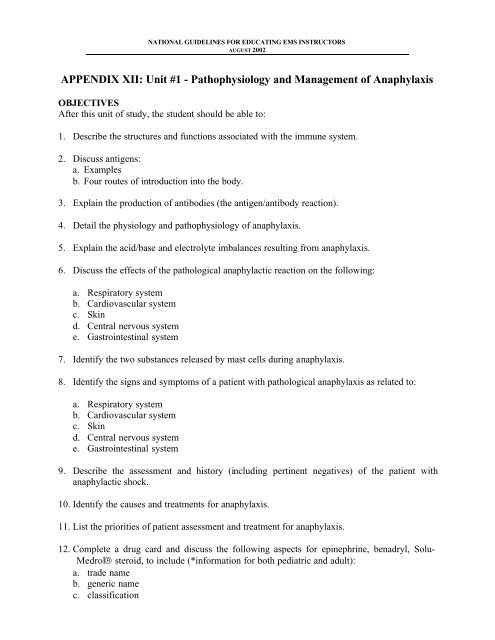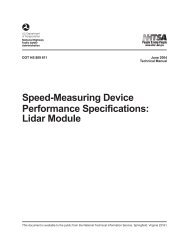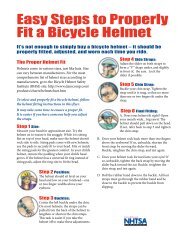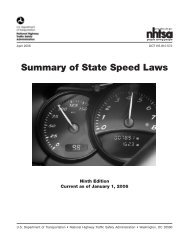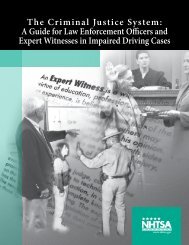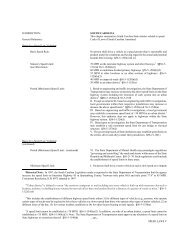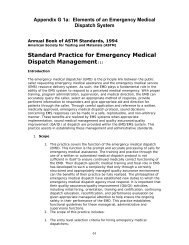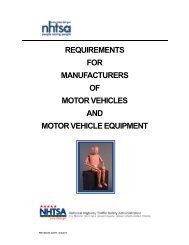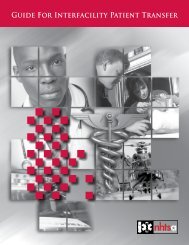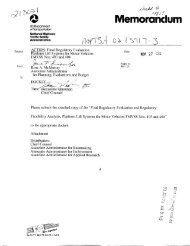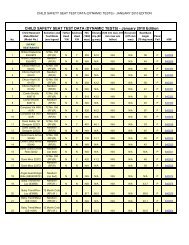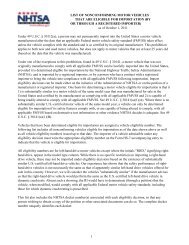Appendix XII - Unit 1 - Pathophysiology and Mgmt of ... - NHTSA
Appendix XII - Unit 1 - Pathophysiology and Mgmt of ... - NHTSA
Appendix XII - Unit 1 - Pathophysiology and Mgmt of ... - NHTSA
You also want an ePaper? Increase the reach of your titles
YUMPU automatically turns print PDFs into web optimized ePapers that Google loves.
NATIONAL GUIDELINES FOR EDUCATING EMS INSTRUCTORS<br />
AUGUST 2002<br />
APPENDIX <strong>XII</strong>: <strong>Unit</strong> #1 - <strong>Pathophysiology</strong> <strong>and</strong> Management <strong>of</strong> Anaphylaxis<br />
OBJECTIVES<br />
After this unit <strong>of</strong> study, the student should be able to:<br />
1. Describe the structures <strong>and</strong> functions associated with the immune system.<br />
2. Discuss antigens:<br />
a. Examples<br />
b. Four routes <strong>of</strong> introduction into the body.<br />
3. Explain the production <strong>of</strong> antibodies (the antigen/antibody reaction).<br />
4. Detail the physiology <strong>and</strong> pathophysiology <strong>of</strong> anaphylaxis.<br />
5. Explain the acid/base <strong>and</strong> electrolyte imbalances resulting from anaphylaxis.<br />
6. Discuss the effects <strong>of</strong> the pathological anaphylactic reaction on the following:<br />
a. Respiratory system<br />
b. Cardiovascular system<br />
c. Skin<br />
d. Central nervous system<br />
e. Gastrointestinal system<br />
7. Identify the two substances released by mast cells during anaphylaxis.<br />
8. Identify the signs <strong>and</strong> symptoms <strong>of</strong> a patient with pathological anaphylaxis as related to:<br />
a. Respiratory system<br />
b. Cardiovascular system<br />
c. Skin<br />
d. Central nervous system<br />
e. Gastrointestinal system<br />
9. Describe the assessment <strong>and</strong> history (including pertinent negatives) <strong>of</strong> the patient with<br />
anaphylactic shock.<br />
10. Identify the causes <strong>and</strong> treatments for anaphylaxis.<br />
11. List the priorities <strong>of</strong> patient assessment <strong>and</strong> treatment for anaphylaxis.<br />
12. Complete a drug card <strong>and</strong> discuss the following aspects for epinephrine, benadryl, Solu-<br />
Medrol® steroid, to include (*information for both pediatric <strong>and</strong> adult):<br />
a. trade name<br />
b. generic name<br />
c. classification
NATIONAL GUIDELINES FOR EDUCATING EMS INSTRUCTORS<br />
AUGUST 2002<br />
d. actions<br />
e. dosage <strong>and</strong> route(s)<br />
f. indications<br />
g. contraindications<br />
h. precautions<br />
i. side-effects<br />
j. indications<br />
k. toxic effects<br />
13. Define <strong>and</strong> explain the following terms:<br />
a) anaphylaxis<br />
b) antigen<br />
c) antihistamine<br />
d) bronchospasm<br />
e) histamine<br />
f) hives<br />
g) immune system<br />
h) mast cell<br />
i) shock<br />
j) steroid<br />
k) urticaria
NATIONAL GUIDELINES FOR EDUCATING EMS INSTRUCTORS<br />
AUGUST 2002<br />
<strong>Pathophysiology</strong> <strong>and</strong> Management <strong>of</strong> Anaphylaxis<br />
lesson<br />
Topic Outline<br />
Assigned Reading<br />
1 Review Shock Syndrome Paramedic Emergency Care Chapter 12,<br />
1. definition<br />
2. parameters<br />
3. aerobic metabolism<br />
4. anaerobic metabolism<br />
Antigens Paramedic Emergency Care Chapter 25 (&<br />
other assigned<br />
readings)<br />
1. definition<br />
2. examples<br />
3. method <strong>of</strong> introduction<br />
2 Antibodies Physiology for the Health<br />
Related Pr<strong>of</strong>essions<br />
1. immune system<br />
2. definition<br />
3. production<br />
Chapter 3<br />
Anaphylaxis<br />
1. pathophysiology<br />
2. effects on systems<br />
3. signs <strong>and</strong><br />
symptoms<br />
4. patient assessment<br />
5. patient history<br />
6. management<br />
Physiology for the Health<br />
Related Pr<strong>of</strong>essions<br />
Chapter 3<br />
3 Pharmacological Agents drug cards <strong>and</strong> master file<br />
1) oxygen<br />
2) epinephrine<br />
a) 1:1000<br />
b) 1:10,000<br />
3) diphenhydramine<br />
4) aminophylline<br />
4 Skills practice<br />
selecting medication - epinephrine<br />
1:1000 or<br />
1:10,000<br />
- benadryl<br />
25mgs or<br />
*note: these<br />
skills are taught<br />
in another course<br />
<strong>and</strong> are only to<br />
be practiced here
NATIONAL GUIDELINES FOR EDUCATING EMS INSTRUCTORS<br />
AUGUST 2002<br />
50mgs<br />
Medication checklist - right<br />
medication,<br />
right route,<br />
right patient,<br />
right dose,<br />
clarity, date,<br />
etc.<br />
select site -<br />
obtain informed consent -<br />
administer medication - observe for<br />
action,<br />
reaction <strong>and</strong><br />
side effects<br />
Course Schedule<br />
EMC 340<br />
Tuesdays & Thursdays 09:15 - 11:30<br />
Spring 2000 Dizney 234<br />
(Refer to complete syllabus for further details)<br />
Date Lesson Topic Reading<br />
01/18 1 Anaphylaxis Paramedic Emergency Care Chapter 12 & 25<br />
01/20 2 Anaphylaxis Paramedic Emergency Care Chapter 12 & 25<br />
01/25 3 Anaphylaxis Paramedic Emergency Care Chapter 12 & 25<br />
Turn in drug cards<br />
01/27 4 Anaphylaxis (skills)


